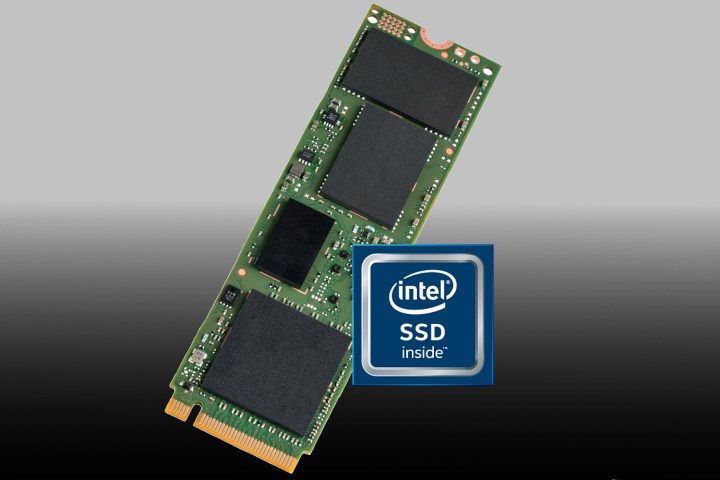
On the consumer front, the company introduced the Intel SSD 600p series. They’re offered in a stick-like 80mm single-sided M.2 form factor that connects to an NVMe or PCIe 3.0 (x4) slot, providing capacities of 128GB, 256GB, 512GB, or 1TB.
The sequential read/write and random read/write speeds vary between all models, with sequential reads ranging from 770MB/s to 1,800MB/s, and sequential writes spanning 450MB/s to 560MB/s. The random reads are between 35,000 IOPS and 155,000 IOPS, and the random writes are between 91,000 IOPS and 128,000 IOPS.
The big deal with these SSDs is that they’re based on 3D NAND instead of traditional NAND. On a whole, SSDs are better than hard drives because data is stored in stationary compartments, rather than on a spinning magnetic platter. However, 3D NAND is better than vanilla NAND because the latter spreads those compartments across a limited, flat neighborhood, while the former stacks compartments vertically like a skyscraper.
Thus, if you look at those storage capacities offered in Intel’s new SSDs, the company managed to cram all that space in such a small form factor by stacking memory, not spreading it all out. 3D NAND is faster, as well, because the skyscraper floors are connected by elevator shafts that data uses to travel up and down. Regular NAND utilizes something like a city-wide grid that connects all the cells together with streets that the data must use to travel from point A to point B.
“Designed for a range of devices from desktops to laptops, the Intel SSD 600p Series will effortlessly manage demanding consumer client applications and easily handle intense multi-tasking,” the company said on Thursday. “The SSD 600p Series will take PCs to a new level of responsiveness with fast application launches and file loading.”
According to Intel, the new 600p series will extend battery life in a notebook thanks to several built-in low power modes. Consumers could see idle power consumption reduced by up to 90 percent when compared to a typical 2.5-inch laptop hard drive. Power is reduced from watts to milliwatts, and if customers throw a sixth-generation Intel Core processor into the mix, those milliwatts could be reduced down even further into microwatts, the company states.
That said, the new 600p Series has a typical power consumption of 100 milliwatts while active, 40 milliwatts when idle, and 5 milliwatts during sleep. Other highlights outlined by Intel include AES 256-bit self-encryption, a five-year warranty, and support for the company’s Solid State Drive Toolbox with Intel SSD Optimizer software suite.
For business customers, Intel now offers the SSD Pro 6000P Series with capacities of 128GB, 256GB, 512GB, and 1TB. Like the consumer models, they’re based on the M.2 form factor and support the PCIe 3.0 (x4) interface. Several solutions for data center applications can be found here as well, and a model for Internet of Things applications right here (SSD E 6000P Series).
As for pricing, the consumer models range from $70 to $360, whereas the business-class models range from $80 to $365 in price. The difference between the consumer and business models is that the latter versions include remote management capabilities, enterprise-grade security, and more business-oriented goodies.
Editors' Recommendations
- Nice try, Intel, but AMD 3D V-Cache chips still win
- AMD’s new Ryzen 9 7950X3D is up to 24% faster than Intel’s best
- AMD Ryzen 7 5800X3D shines in gaming benchmarks, beats Intel
- AMD’s 3D-stacked Ryzen 7 5800X3D is ‘world’s fastest gaming processor’
- New 3D printed satellites are impervious to heat, cold, and cosmic radiation


